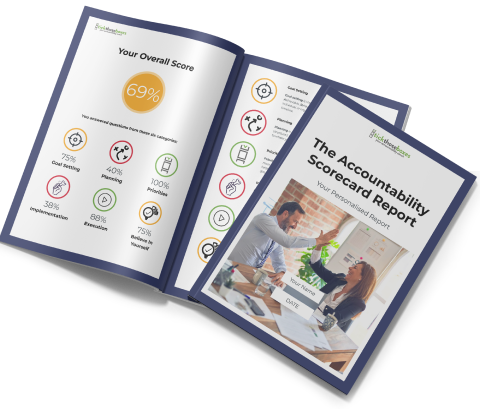
Accountability for Business Owners
Learn how accountability can help business owners build more sustainable
The Accountability Guy®

In today’s dynamic and competitive work environment, accountability is a crucial aspect that can make or break the success of individuals and organizations. The ‘Ladder of Accountability’ concept helps individuals understand their level of responsibility and ownership in the workplace. It represents a range of behaviours, from the bottom rungs characterized by blame and avoidance to the top rungs marked by proactive problem-solving and taking ownership of one’s actions. In this blog, we will explore the different levels of the ‘Ladder of Accountability’ and discuss how you can climb to the top rungs to foster a culture of accountability and achieve personal and organizational excellence.

Discover your Accountability Score and increase the probability of smashing your GOALS and Getting Sh!t Done!
The “Accountability Ladder” is a model or framework that helps individuals and organizations understand different levels of accountability and responsibility. It provides a visual representation of the various attitudes and behaviours that individuals might exhibit regarding taking ownership of their actions and decisions. The Accountability Ladder typically consists of several rungs or levels, each representing a different degree of accountability and responsibility. The model helps individuals recognize where they currently stand on the ladder, identify steps to climb higher and embrace a greater sense of accountability.
Level 1: Denial and Avoidance
Denial and avoidance lie at the bottom rung of the ‘Ladder of Accountability’. Employees at this level tend to avoid responsibility for their actions and decisions. When faced with challenges or mistakes, they often deflect blame onto others or external factors. This behaviour hinders personal growth and prevents individuals from learning from their experiences. In organizations where denial and avoidance are prevalent, a toxic blame culture can emerge, leading to a lack of trust and accountability.
Level 2: Blame Game
Moving up the ladder, we find the blame game. At this level, individuals might acknowledge their mistakes but quickly shift the blame onto others. This behaviour damages team dynamics and inhibits the growth and collaboration necessary for a thriving workplace.
Level 3: Compliance
The middle rungs of the ‘Ladder of Accountability’ are characterized by compliance. Employees at this level might accept responsibility when confronted, but their actions are primarily driven by external pressure, such as fear of punishment or desire for rewards. While compliance can ensure adherence to rules and policies, it often needs more intrinsic motivation for proper accountability and exceptional performance.
Level 4: Responsibility
Reaching the fourth rung signifies the level of responsibility. At this stage, employees take ownership of their actions and decisions. They willingly acknowledge their mistakes and actively work to rectify them. Individuals at this level show dedication to their roles and understand how their contributions impact team and organizational success.
Level 5: Proactive Problem-Solving
At the penultimate rung, individuals demonstrate proactive problem-solving skills. They take ownership of their responsibilities and anticipate challenges and actively work to prevent them. These employees go above and beyond their duties and consistently look for ways to enhance efficiency and effectiveness.
Level 6: Empowerment and Leadership
The pinnacle of the ‘Ladder of Accountability’ is marked by empowerment and leadership. Individuals at this level demonstrate proactive problem-solving and empower and inspire others to do the same. They take accountability for their actions and the overall success and well-being of the team and organization.
Moving up on the levels of the Accountability Ladder requires conscious effort, self-awareness, and a commitment to personal growth and development. Here are some steps and strategies to help you climb higher on the Accountability Ladder:
The Accountability Ladder is a valuable tool for personal and professional development, as it encourages individuals to reflect on their behaviour and attitudes towards accountability. By identifying their current level on the ladder, individuals can work towards climbing higher and fostering a culture of accountability within their teams and organizations. So, where are you on the ‘Ladder of Accountability’? It’s always possible to take the first step towards growth and success. Remember that climbing the Accountability Ladder is a continuous journey, and progress may not always be linear. Be patient with yourself and be willing to adapt and learn from setbacks.

Darren Finkelstein, The Accountability Guy®, is the founder of TICK THOSE BOXES, a specialised accountability coaching practice. Darren is a formidable international accountability coach, business advisor, mentor, and author/speaker, fostering development and measurable results in entrepreneurship, leadership, and accountability. Darren’s tale is one of perseverance, self-reinvention, and resilience.
With compelling execution, Darren has empowered high-achieving individuals and teams from Australia and New Zealand to Latin America, Europe, Asia, the UK, and the US to embrace accountability; after all, it is your superpower.
Darren’s one-on-one and group coaching programs are based on his bestselling business book, “The Accountability Advantage – Play your best game” and the latest, release “NO’ – Building a life of choice without obligation”.
Darren has an impressive background in business, having held the role of “Manager of Commercial Markets” at Apple Australia during the Steve Jobs revolution.
He enthusiastically “walks the talk,” having also successfully sold and exited his lifestyle businesses, which served as the impetus for establishing his coaching and mentoring business.
Join Darren on this transformative quest to accomplish the remarkable.
Read Darren’s full bio here:
https://tickthoseboxes.com.au/about/

Know what to do first

know what to do next

know what to do more of

Learn how accountability can help business owners build more sustainable

Boost productivity and trust within your team. Unveil the power

Learn about Positive Accountability, see what it is, why you

Accountability drives success in so many ways. Whenever I coach

Are You Responsible or Accountable? The underlying principles undoubtedly apply

Discover why accountability is crucial for effective leadership. Learn how
Navigation
Learn More
Contact
Social Media
Copyright Darren Finkelstein 2022 | Privacy Policy | Terms and Conditions